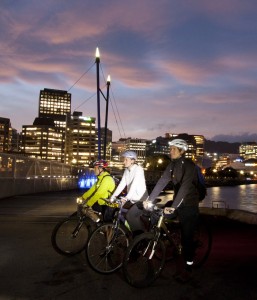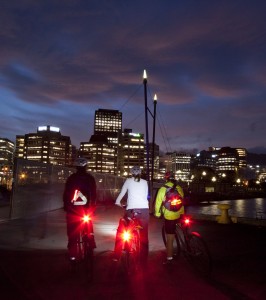 Guest post by Simon Kennett, previously published in Chainlinks
Guest post by Simon Kennett, previously published in Chainlinks
“Know what’s weird? Day by day, nothing seems to change, but pretty soon…everything’s different.”
– Calvin from Calvin and Hobbes
Calvin probably wasn’t talking about bicycle lights, but the quote applies beautifully in two ways.
Traditionally, the main problem with bike lights is that they get slowly dimmer, day by day, week by week. So slowly in fact, that most cyclists don’t notice until the light is virtually dead.
And the slow, almost imperceptible, rate of change is only part of the problem. Many lights still manage to pump out impressive light for a couple of minutes after being turned on, even when the batteries are almost flat. You could be riding along, and pretty soon… everything’s different… you’re cruising through traffic with a dead light a few minutes after setting off (and if it’s your rear light, how will you know until you reach journey’s end?).
This traditional problem is easily fixed with fresh batteries (put in your lights well before your present ones run low). For extra brightness, do yourself a favour and splash out on some lithium batteries. They’ll probably last three times as long as the ones your light came with. If you’re lucky enough to have a flash, modern light (especially a rechargeable one) it should have a low-battery indicator.
The new problem – the 21st century problem – is the rate of change of bicycle light technology. Here at Greater Wellington Regional Council we’ve been testing lights each winter since 2010. This year we teamed up with Consumer NZ and tested 82 bike lights in the sub-$100 range. Many of the better lights from 2010 have slipped well down the rankings. While 100 Lux seemed bright a couple of years ago, two AA batteries can now generate up to 1000 Lux – everything’s different! Some lights shone well at an angle of 45 degrees (a critical feature at intersections) while others registered almost nothing at that angle.
When you’re commuting through winter, your lights are competing for attention with dozens of other light sources, many of which are significantly brighter these days. You might find yourself wondering – ‘Do my lights still demand attention from drivers?’ And while some of the more expensive lights can be dazzling, that’s not actually causing accidents. ‘Lights too dim’, however, is often listed in crash reports as a factor contributing to cycling accidents.
If you are thinking about upgrading your old bike lights, check out our 2013 lights test results at http://www.gw.govt.nz/be-safe-be-seen/ Because the New Zealand bike industry is not bound by any bicycle lights standards, your local shop will present you with a wide range of quality ranging from shiny to blinding. Let the buyer beware.
 The top-ten in our 2013 test were:
The top-ten in our 2013 test were:
Rear Lights:
Moon Shield, Lezyne Micro Drive, NightRider Cherrybomb (1W and 0.5W), Ontrack Beacon II, Moon Comet, Valiente Supreme, Cateye Rapid (5 and 3), and Smart SuperFlash.
Front Lights:
Lezyne Micro Drive, Ontrack Phazer 240, NiteRider Mako (2W and 1W), Topeak Whitelite HP 1W, Cateye Econom EL 540, Blackburn Super Flea, Torch High Beamer Tactical, Moon Mask, and Blackburn Voyager.



